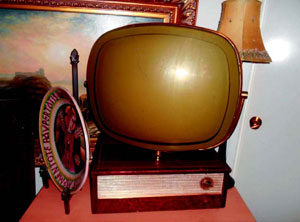
Since JP sent me a photo of a 1958 Philco TV set which looks like an incredible dinosaur, I found some quotes about inventions thought improbable in their time:
- Charles Howard Duell, the U.S. Commissioner of Patents in 1899, said “Everything that can be invented has been invented.”
- In 1977, Ken Olson, the Founder of Digital Equipment Corp. said “There is no reason anyone would want a computer in their home.”
- In 1876 Alexander Graham Bell offered to sell his telephone patent to Western Union for $100,000. Western Union declined. “Why would any person want to use (such a device as a telephone) when he can send a messenger to the telegraph office and have a message sent? This device is hardly more than a toy; the idea is idiotic; this device will never be capable of sending recognizable speech.”
- Henry Morton, President of the Stevens Institute of Technology said in 1880 “Everyone acquainted with the subject of Edison’s light bulb will recognize it as a conspicuous failure.”
- In 1913 the U. S. District attorney prosecuted Lee De Forest for selling stock in his Radio Telephone Company. “Lee De Forest has (told the public) that the human voice would cross the Atlantic. Based on these absurd and deliberately misleading statements, the misguided public has been persuaded to purchase stock in his company.”
In 1926, the same genius De Forest said, “While theoretically and technically television may be feasible, commercially and financially it is an impossibility, a development of which we need waste little time dreaming.” Such things were said about capturing an image in a tube, regarding JP’s anthropomorphous television set. We will hear more about Cyclops later, by the way.
JP’s set is a 1958 Philco Predicta television with a swiveling 21″ screen, a base unit of a cloth covered speaker joined to a teak stand. I wonder about the room in which a family first fired up this set. They watched shows on only three stations.
Among the top ten favorites in 1958:
- Maverick on ABC
- The Danny Thomas Show on CBS
- Wagon Train on NBC.
I bet many of you reading this remember only having three channels to choose from. Actually it made life easier. But how did television come to be?
Russian pioneer Constantin Perskyi presented a paper at the first International Congress of Electricity held at the World’s Fair in Paris in 1900. He made the first known use of the word “television,” speaking about a confluence of inventions that amalgamated into the devise we see illustrated.
At the turn of the last century many inventors from places as diverse as Scotland and Russia all independently worked on the ideas around TV. The inventors then left the gate with discussions driving the future of television in two separate directions. One a mechanical system, based on Paul Nipkow‘s rotating disks. Two, an electronic system, based on inventions by Campell-Swinton and Rosing. The electronic system won, through the inventions of Philo Farnsworth and Vladimir Zworykin.
The history of JP’s television seems as fascinating as the poor predictions I mentioned in my first paragraph.
Here’s what happened:
Philo Farnsworth became a hit, and left his legacy in the TV company Philco. The first Philco Predicta appeared on the market in 1958, after Henry Bowes, Philco’s marketing VP, recognized a need for a “dramatic gimmick to spice up television sales.” Bowes lured two designers, Severin Jonassen and – amazingly, a female German émigré designer, Catherine Winkle, to re-invent the form or the look of a television set. Winkle and Severin mounted the picture tube part of the TV on a pedestal and used what looks to me like a giant ice tong to make it swivel.
Some of these pedestals were more remarkable than the short rectangular pedestal we see in JP’s TV. The most futuristic style of the Predicta had a 40 inch tall pedestal (nicknamed one of the following: “The Gas Pump” or “Cyclops” or “the Barber Pole”) which had a faux mahogany base cabinet with a plastic control module, upon which the picture tube was mounted. These sell for $1,000 today, and JP’s Predicta model, with a table top base, sells today for $600 in top shape.
As fast as they became the range, the Predicta dropped in market share. Around 1960, color TV entered the market, and the Predicta models received black and white only. Due to the high mount of the picture tube, a full 21″, and sometimes functioned poorly, the Predicta (1958-62) line got shelved. At the same Ford released the Edsel. Philco went bankrupt in 1962. Today, collectors call the Predicta models not “Cyclops” but “the Groove Tube.” If you purchase one, be careful, vacuum tubes are not easy to come by, and JP’s set needs a few, so its value is slightly less than the estimate of $600.